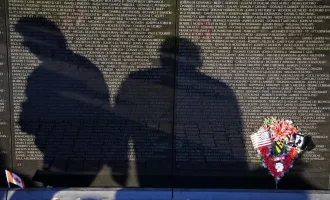
Throwback Thursday: The 'M' Word
On this day in 1998, in the seemingly not-so-distant UC past, the Synapse front page read, “One Year After Merger, UCSF Stanford Faces Unexpected Problem”. When asked about their biggest concern, administrators from the merged hospital system of UCSF and Stanford cited worries about the computer systems surviving the Y2K bug. (People may recall that the virus caused widespread fear that all computer systems would fail on January 1, 2000.) However, the now-infamous merger, or the dreaded “M” word, which was supposed to unify these two giant institutions, faced more than just one problem during the tumultuous three years between its inception in January 1996 to its eventual dissolution in November 1999.
As with most big ideas, it all began with good intentions. In January 1996, UCSF Chancellor Joseph B. Martin introduced the idea of a merger with Stanford Medical Center, claiming that it would be necessary for the long-term survival of UCSF. The university would benefit from reduced spending, shared investments in clinical programs and savings that would increase support for education and research, said Martin. The merger also promised an opportunity for UCSF to maximize services and attract more patients. Also motivating UCSF and Stanford were an increasing presence of “managed care companies” in the healthcare marketplace and decreasing federal support for medical education and research.
However, while faculty, staff and students shared the Chancellor’s concern for these critical issues facing UCSF, opposition against the merger rose quickly. People viewed the merger as costing jobs, affecting research and creating an unskilled workforce. A coalition of unions representing UCSF Medical Center employees protested over the potential impact on the terms and conditions of employment. Also causing a backlash was the exclusion of students from discussions and denying UCSF student governments and Student Association access to any information. Critics of the merger questioned how UCSF Stanford Health Care (USHC) could fund graduate education at the UC health professional schools with the need for more clinical programs to serve a greater number of patients.
Between June and November 1996, discussions, meetings and talks between UC administrators, the UC Board of Regents and UC employees did little to hinder the merger. Faculty, staff and students felt that their concerns went unaddressed and their voices shut out, and that those in power were making decisions behind closed doors without recognition of the potential effects on education, patient safety and services at UCSF. Where there were questions surrounding specific details of the planning, information was withheld or concerns dismissed with sweeping generalizations and predictions of the merger’s benefits.
Regardless of the controversy and overall skepticism, on November 15, 1996, the UC Board of Regents voted to create the USHC, a private, non-profit corporation that cost $8.25 million in start-up funds. Three years later, by October 1999, the financial results spoke for themselves: USHC lost an estimated $46 million in its first two years, a difference of $111 million from the predicted gain of $65 million for this period. According to Synapse’s “Brief Synopsis” about the merger, costs accrued from difficulties in “combining intellectual capital, integrating clinical programs, reductions in reimbursement rates, insufficient cost savings and greater than anticipated merger costs.”
Beyond the financial losses, legal proceedings plagued the USHC board over USHC’s denial of employee rights to union representation and collective bargaining. Protests grew over anticipated layoffs and funding cuts to Mount Zion after a $10.7 million deficit in the first quarter of the fiscal year and continual losses in 1999. The responses and decisions made by the USHC board, such as transferring Mount Zion’s inpatient and emergency services to Moffit-Long hospital, did little to staunch the losses or to alleviate the growing unrest and criticism of this failed experiment.
In November 1999, Synapse announced that the merger will be dissolved, just in time to avoid the Y2K virus. In a statement, UCSF Chancellor J. Michael Bishop announced that Stanford University withdrew from the two-year-old merger. In his letter, President Gerhard Casper of Stanford University recognized that this endeavor had no precedent but ultimately was too much to take on, admitting that simply merging hospitals was not enough and that they had failed in achieving a common UCSF Stanford healthcare culture. Both sides acknowledged that the transaction costs were far greater than expected, that “energy has been sapped and great weariness has crept in, [and] many fear paralysis.” In spring of 2000, the merger was officially dissolved.
News of the dissolution at UCSF drew mixed reactions. Some believed that though this corrected a wrong, it was too little too late as many jobs were lost and the damage had been done. Other campus members were delighted at the news because they felt the merger had a very negative effect on UC. Students felt generally unaffected since the changes happened so rapidly and they never knew what to expect. UC employees were unsure how long the recovery period would be and what the long-term repercussions of this dissolution would have on the relationship between UCSF and Stanford.
In light of the outcome, key lessons were learned from this merger experiment, most notably that it is imperative to involve faculty, staff and students in any project for their input and opinions. Also, through all endeavors, UCSF must maintain its core mission and focus on providing high quality patient care over reputation and financial gain. Open communication, polling, small-group and town-hall meetings are all ways to strengthen relations and ensure that a mechanism is in place to involve the UCSF community.


